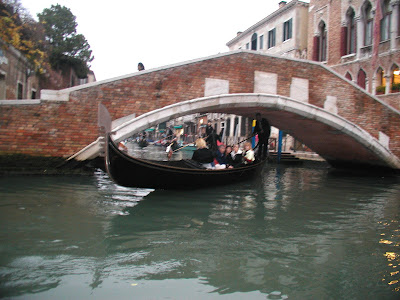
peering through his fingers in despair

Last Judgment by Michelangelo

Birth of Venus by Bottecelli
Additional thoughts: At the Uffizi, Ricardo II pointed out the look of melancholy on the face of Bottecelli's Venus as she rises from the sea, even as she is being carried toward land by the Zeyphers. She appears sad, because, says Ricardo, the Renaissance, even as it rode the crest of learning into a new and self-confident age, knew all things would pass away. Then he quoted a poem written by Lorenzo de Medici, which also appears in George Eliot's "Romolo" as a song sung by Tito to wake Nello, the literate barber. Ricardo's translation is better, but here is the footnote that translates Eliot's version:
Beauteous is life in blossom
But it fleeth - fleeth - fleeth ever.
Whoever would be joyful, let him.
There is no surety for the morrow.
Later, looking at a closeup of the David's gaze in the guide book, and prompted by Ricardo's insight, I see something besides alertness and self-confidence. I see something very natural and at the same time symbolic. I see fear. Could that note of apprehension be related to the melancholy on Venus' face? Could Michelangelo at 26 have seen the "dark side" of the Renaissance as Keats did the dark side of Romanticism? (Keat's died at 26.) Could Michelangelo have seen how easily self-confidence can turn to pride? The idea that man is the measure of all things can be a dangerous and even fatal turning away from the fear of God.
The Hebrew scriptures declare fear is the beginning of wisdom. This is practically the whole theme of Eliot's Romolo, which I am still reading here in Venice. Her determination to dump into the novel all the fruits of her exhaustive research marrs the novel, yes, but I scarcely know of a wiser book or more luminous passages than appear on pages 179-182 of the Modern Library Edition. Here we see Tito, quivering with Renaissance excitement, sowing the seeds of Romola's unhappiness, and perhaps his own. To the surprise of everyone who knows only the stereotype of the Savanarola, she paints an almost sympathetic picture of the zealous monk who warned against the excesses of materialism and self confidence. But Michelangelo, too, listened to Savanarola and I will venture, put some of what he heard into the "Last judgment", painted twenty years later in the Sistine Chapel. The seated figure midway up that work, peeking through his fingers in despair, knows that man is not the measure of all things. His face, perhaps, completes the gaze of David.



















































